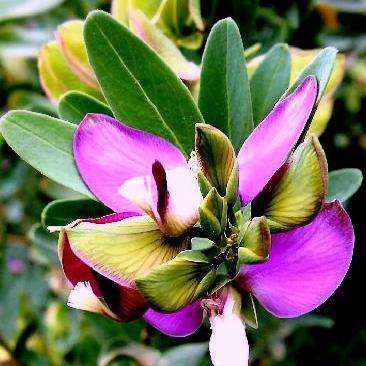
Polygala virgata Seeds - Purple broom; Persboom, Bloukappie - Indigenous South African Shrub
Check my rate
| Main centres: | 1-3 business days |
| Regional areas: | 3-4 business days |
| Remote areas: | 3-5 business days |

| Main centres: | 1-3 business days |
| Regional areas: | 3-4 business days |
| Remote areas: | 3-5 business days |
Common Names: Purple broom; Persboom, Bloukappie
This charming slender shrub, bearing spikes of bright purple magenta winged flowers is an eye-catcher in any garden. Polygala virgata is one of the beautiful species belonging to the Polygalaceae family also commonly known as the milkwort family. Polygala virgata is an erect, evergreen shrub and grows to a height of 1,5 to 2,5 m. A single stem is formed at the base of the plant and slender hairless branches occur at the top. Simple leaves are alternately arranged on younger branches and usually drops before flowering. The leaves are narrow in shape, dark green with a velvety texture and 10 mm in length. Drooping racemes of deep purple magenta flowers are borne at the ends of branches. The flowers look similar to that of a pea family Fabaceae, but are different. The flower is enclosed by 2 large purple bonnet-like bracts and streaked with darker veins. These open to show that the flower has a purple tuft of tiny hairs at the top of the lower keeled petal. The outer two petals surround the lowest petal like a bonnet. The purple tuft of hairs is a distinctive characteristic to identify all polygalas. Peak flowering time is from September to February. The fruit is a two-celled capsule and the seed is small, black and oval shaped. Polygala virgata grows naturally on lower slopes and edges of bushy hillsides and along stream banks. It grows in sandstone, clay or limestone slopes and along forest margins. Protected by other trees and shrubs. It has a wide distribution and occurs both in Tropical and East Africa, southwards through Natal, Transvaal, into the Cape as far as George. Growing in the Drakensberg it is found at an altitude of 250 to 1800 m. Polygalaceae (milkwort family) is a large family with 17 genera and 950 species found throughout the world in temperate and warm climates. Of 400-450 African species, 32 occur in Cape region. The genus Polygala consists of about 600 species with 232 species in Africa and Madagascar of which approximately 88 species occur in southern Africa. The genus name Polygala was given by Linnaeus, derived from the Greek polus meaning many or much and gala meaning milk refers to supposed property of European species to increase milk in cows if grazed. The leaves and stems were traditionally prepared and used as blood purifiers. The plant is grazed when in reach of stock and game. The beautiful flowering sprays can be used in a vase with a combination of flowers and green fillers. The shrub is a buzz with bees, insects and bumblebees attracted to the bright purple magenta flowers. The bid amount is for 1 Seed We'll supply you with all the germination & care instructions. |